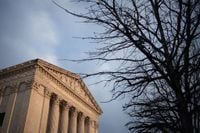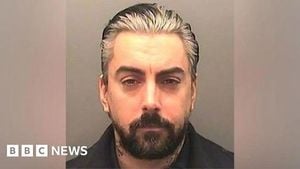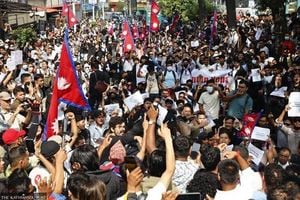On October 1, 2025, the U.S. Supreme Court announced it will hear arguments in January 2026 over President Donald Trump’s unprecedented attempt to remove Federal Reserve Governor Lisa Cook, a legal battle that could reshape the independence of the nation’s central bank and redefine the limits of presidential power. The court’s decision to take up the case, rather than rule immediately, leaves Cook in her position for now and sets the stage for a high-stakes confrontation that has economists, policymakers, and legal scholars watching closely.
This dispute marks the first time in the Federal Reserve’s 112-year history that a president has tried to fire a sitting Fed governor. The Federal Reserve Act, passed by Congress in 1913, was designed to insulate the central bank from political interference. Under the law, governors are appointed for staggered 14-year terms and can only be removed by the president “for cause”—a term that Congress left undefined, leaving its interpretation to the courts. Until now, that provision had never been tested in court.
Lisa Cook, who became the first Black woman to serve as a Federal Reserve governor after her 2023 nomination by then-President Joe Biden, found herself at the center of this historic legal and political storm. In August 2025, Trump announced on social media that he was removing Cook from the Board of Governors, citing allegations that she had committed mortgage fraud prior to her confirmation. Specifically, Trump claimed that Cook designated both a house in Michigan and a condo in Atlanta as her “primary residence” within a two-week period when taking out loans—an accusation Cook has vigorously denied.
Cook responded by suing Trump in federal court, arguing that the allegations were a pretext for firing her due to disagreements over monetary policy. According to Reuters, Cook’s legal team stated that Trump’s actions "did not give the president the legal authority to remove her and were a pretext to fire her for her monetary policy stance." In her filing to the Supreme Court, Cook labeled the allegations as “flimsy,” “unproven,” and “conveniently timed following the President’s criticism of the board’s policy decisions.” She insisted there was no legal or factual basis for her removal, and that the president’s broad interpretation of “for cause” would undermine the Fed’s independence.
The case landed before U.S. District Judge Jia Cobb, who ruled on September 9, 2025, that Trump’s claims likely did not constitute sufficient grounds for removal under the Federal Reserve Act. Cobb reasoned that the “for cause” requirement does not contemplate removing an individual for conduct that occurred before they began in office. She also found that Trump’s attempt to fire Cook likely violated her due process rights under the Fifth Amendment, as she had a property interest in her position and was entitled to notice and an opportunity to be heard before removal. As Cobb wrote, if a court is “confronted with a justification offered by the President that clearly does not fall within the President’s statutory authority, it has responsibility to review that determination.”
The U.S. Court of Appeals for the District of Columbia Circuit affirmed Cobb’s order, refusing to pause her ruling while litigation continued. The Trump administration, through Solicitor General D. John Sauer, then turned to the Supreme Court, calling Cobb’s order “yet another case of improper judicial interference with the President’s removal authority.” Sauer argued that the president’s discretion to remove officials for cause should be “unreviewable,” and that requiring notice and a hearing would “wreak havoc on sensitive presidential decision-making.”
The Supreme Court, in a brief unsigned order, declined to immediately stay Cobb’s ruling, instead deferring a decision until after oral arguments in January 2026. This means Cook remains in her post and will likely participate in at least two more key Federal Reserve policy meetings, including ones in October and December 2025, where further interest rate cuts are widely anticipated. According to Reuters, Cook recently participated in the Fed’s September meeting, voting in favor of a quarter-point rate cut amid concerns about a weakening job market.
The timing of the Supreme Court’s hearing is significant. January is when regional Federal Reserve presidents are reappointed to new five-year terms by the Board of Governors. Trump, who has signaled a desire to reshape the Fed’s leadership, would need a majority on the board to replace regional presidents or even appoint a new Fed chair once Jerome Powell’s term expires in May. With Cook still on the board, any reshuffling of leadership is on hold until the court resolves her status.
Beyond the personal and institutional drama, the case has far-reaching implications for the Federal Reserve’s ability to set monetary policy free from political pressures. Central bank independence is widely seen as essential for controlling inflation and maintaining economic stability. Cook’s lawyers warned in their statement that granting Trump’s request “would eviscerate the Federal Reserve’s longstanding independence, upend financial markets and create a blueprint for future presidents to direct monetary policy based on their political agendas and election calendars.”
For its part, the Trump administration maintains that so long as the president identifies a cause for removal—such as the mortgage fraud allegations—the decision falls within his “unreviewable discretion.” In a Supreme Court filing, the Justice Department argued, “Put simply, the President may reasonably determine that interest rates paid by the American people should not be set by a Governor who appears to have lied about facts material to the interest rates she secured for herself—and refuses to explain the apparent misrepresentations.”
The Supreme Court’s willingness to hear arguments—rather than rule summarily—signals that the justices recognize the unique status of the Federal Reserve as a "uniquely structured, quasi-private entity" with a singular historical tradition, as noted in a recent decision. The court’s conservative majority has recently sided with Trump on removal powers over other federal agencies, suggesting a possible shift away from longstanding precedents that protected agency independence. However, the Fed’s special role and structure may prompt a different outcome.
Meanwhile, Cook continues to perform her duties and receive her salary, never having left office since the removal attempt. As reported by SCOTUSblog, Cook’s brief to the court argued that “there would be no need for a court to reinstate her to her position if she eventually prevails in her challenge, because she has never left office.” The Supreme Court’s January arguments will also address whether federal courts have the power to issue preliminary injunctions reinstating removed officers, adding another layer of constitutional complexity to the case.
This legal showdown comes amid broader debates over presidential powers and the autonomy of independent federal agencies. The outcome could set a precedent not only for the Federal Reserve, but for the future of agencies that Congress has tried to shield from the shifting winds of politics. As the nation awaits the Supreme Court’s decision, the stakes—for monetary policy, for the rule of law, and for the delicate balance between the executive branch and independent regulators—could hardly be higher.
The coming months promise a pivotal chapter for the Federal Reserve and for the boundaries of presidential authority, with the eyes of Wall Street, Washington, and the world watching closely.




